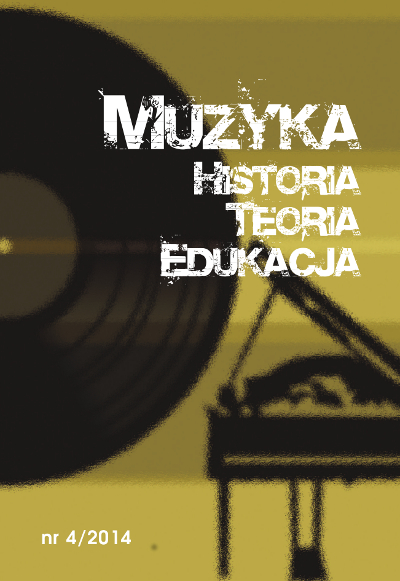Spojrzenie klasyka XX wieku na barokową formę koncertu na podstawie „Koncertu na obój i harfę” Witolda Lutosławskiego
DOI:
https://doi.org/10.34767/MHTE.2014.04.03Abstrakt
The object of research paper is an attempt to read the Classic looks of the 20th century - Witold Lutosławski on the Baroque form. The author indicates the characteristics of the term classicism in art, which becomes the basis for finding them in Concert for oboe and harp. Shows the elements of the composition, which interacted with the classic trend is characterized by moderation, balancing, peace and respect for tradition. Considering the extent to which the personality of the creator of new standards and standards-setting moves to creative materials. Shows how the Baroque form of the concert could inspire the composer of the 20th century. Genesis and circumstances of the concert is the starting point for the analysis of the work, which is looking for an answer to the question what makes a Concert represents a synthesis of modern musical language, style and compositional techniques with the traditional form of the concerto grosso of the independence of the material between the parties in the concertino and concerto. Characterized by a musical language indicating elements anchored in the past in relation to the characteristics of the thoroughly modern. Responding to the question of whether to base work on the series always assigns a category theme of modernity. Describes the role of the departing design layer architectural form works shape designating the mitral cell by the composer earned and wonders what purpose has back to the classic three-pieces schema. Correlation characteristics of the late composer, among others: back to the melody and structure of motive-themed shows at the same time its belonging to music second mid-20th century. Looking for an answer to the question what a load of expression carry with themselves and why rhythm and quality-metric. Another step is recognizing the direction of narrative story and the elements of music works which have an impact on the formation way. At the end of the reflection appears what is the ability to call their own, modern musical language with the traditional form of the concerto grosso, and also how does the Baroque master in the context of a formal expression of the contemporary far from lavish, moving into the realm of intellectual experience rather than a sensual experience. the author he argues with thesis, that concert is saddled with “lesser species weight”.
Bibliografia
Bauman-Szulakowska Jolanta, Forma sonatowa w XIX i w pierwszej połowie XX wieku, gatunek koncertu od baroku do neoklasycyzmu, przegląd historyczny i analityczny, Akademia Muzyczna im. K. Szymanowskiego, Katowice 2003.
Gołąb Maciej, Spór o granice poznania dzieła muzycznego, Uniwersytet Wrocławski, Wrocław 2003.
Gwizdalanka Danuta, Meyer Krzysztof, Lutosławski, Droga do mistrzostwa, PWM, Kraków 2004.
Nikolska Irina, Rozmowy z Witoldem Lutosławskim, PWM, Kraków 2003.
Nowak Anna, Współczesny koncert polski, Akademia Muzyczna im. F. Nowowiejskiego, Bydgoszcz 1997.
Paja-Stach Jadwiga, Lutosławski i jego styl muzyczny, Musica Iagellonica, Kraków 1997.
Paja-Stach Jadwiga, Witold Lutosławski, Musica Iagellonica, Kraków 1996.
Rae Charles Bodman, Muzyka Lutosławskiego, PWN, Warszawa 1996.
Skowron Zbigniew (red.), Estetyka i styl twórczości Witolda Lutosławskiego, Musica Iagellonica, Kraków 2000.
Szlagowska Danuta, Muzyka baroku, Akademia Muzyczna im. S. Moniuszki, Gdańsk 1998.
Tatarkiewicz Władysław, Dzieje sześciu pojęć, PWN, Warszawa 2006.

